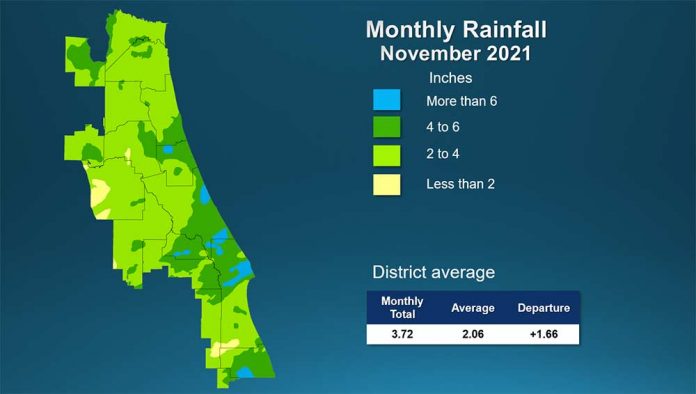November brought above-average rainfall, with most of the activity occurring between Nov. 5 and Nov. 6. The remainder of November was dry.
A full report outlining November’s hydrologic conditions was presented at the District’s Governing Board meeting Tuesday. Highlights include:
Rainfall
- Districtwide, November rainfall averaged 3.72 inches, which is 1.66 inches above the long-term average for the month.
- The counties with the highest rainfall totals were Seminole and Indian River which each received over 4.5” rain.
- The county with the least rainfall in November was Marion, which received 2.77”.
- Districtwide, the cumulative rainfall total for the past 12 months is 50.66 inches, which is 0.35 inches below the long-term average.
Groundwater
- Upper Floridan aquifer conditions (groundwater levels) at the end of November were either in the high or normal range throughout the District. Water levels in many of the wells used for this report remained consistent with October’s levels.
- Groundwater levels are at the 84th percentile Districtwide. This means that since 1980, aquifer levels have been higher than they currently are about 16 percent of the time.
Surface water flows
- On Dec. 1, flow in most stations across the District was in the average range. The exception was the Econlockhatchee River at Chuluota station which exhibited very high flow on Dec. 1, and the St. Marys River, which exhibited high flow.
- On Dec. 1, flow in the St. Johns River’s headwaters at the Melbourne station was 231 million gallons per day (mgd) (45th percentile).
- Flows in the Econlockhatchee River near Chuluota were in the very high range at 190 mgd (91st percentile).
- Flow in the Wekiva River near Sanford was in the average range at 147 mgd (39th percentile).
- Flow at the St. Johns River DeLand station was in the average range at 3,018 mgd (67th percentile).
- Flow in the Ocklawaha River, the largest tributary to the St. Johns River, was in the average range at 554 mgd (52nd percentile).
- Flow at the St. Johns River near Satsuma station was in the average range at 5,819 mgd (57th percentile).
- Flow in the St. Marys River near Macclenny was in the average range at 181 mgd (79th percentile).
Lake levels
- Lake Brooklyn water levels decreased 0.1 foot to 100.8 feet in November.
- Lake Weir decreased by 0.1 foot to 53.6 feet.
- Lake Apopka increased by 0.2 feet to 65.7 feet. Lake Apopka is part of a system with water control structures that are operated by the District.
- Blue Cypress Lake levels increased to 22.9 feet, even with the regulation schedule for this time of year. Blue Cypress is also part of a system with water control structures that are operated by the District. During April and May, the regulation schedule levels drop in preparation for the summer wet season.
Spring flows
- The mean monthly flow at Silver Springs decreased to 788 cubic feet per second (cfs), or 510 mgd, which is a 32 cfs decrease from October’s mean.
- At the Blue Spring station in Volusia County, the mean monthly flow was 162 cfs, or 105 mgd.
- At Rock Springs, the monthly mean flow increased 1 cfs to 63 cfs (41 mgd), which is in the high range for November.
- Mean monthly flow at Wekiwa Springs decreased slightly to 64 cfs (41 mgd), which is in the normal range for the time of year.
To learn more about rainfall totals and other hydrologic data collected, visit sjrwmd.com.
Visit WaterLessFlorida.com for tips to help landscapes thrive while saving water and money. Watch the weather and wait to water during Florida’s summer rainy season. Follow the water conservation conversation at #sjrwmd #waterconservation #savewater.










